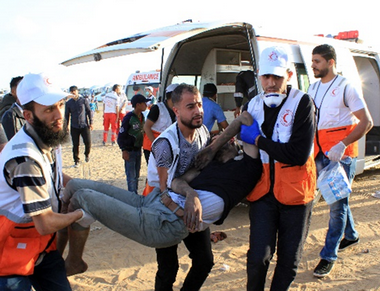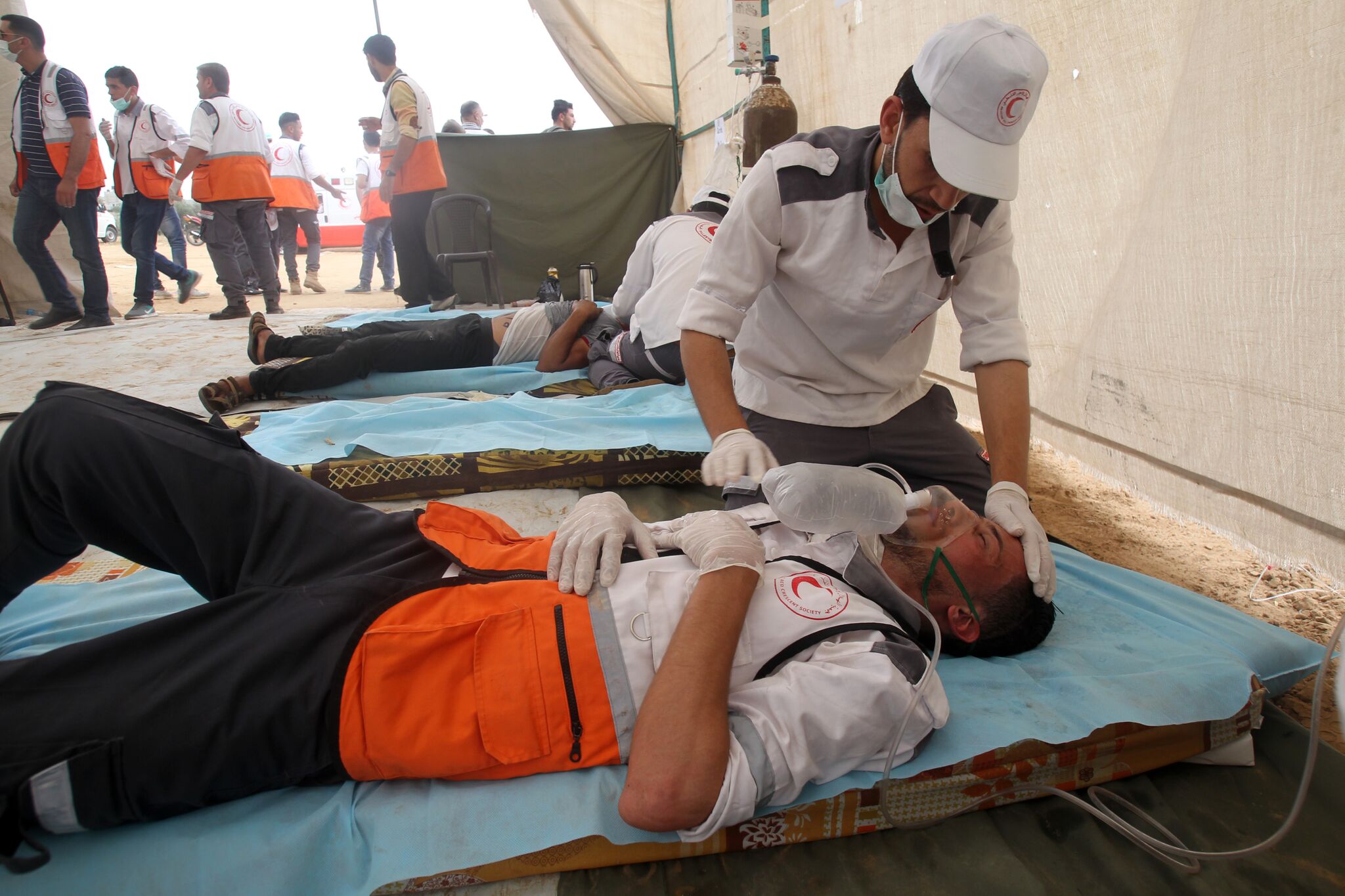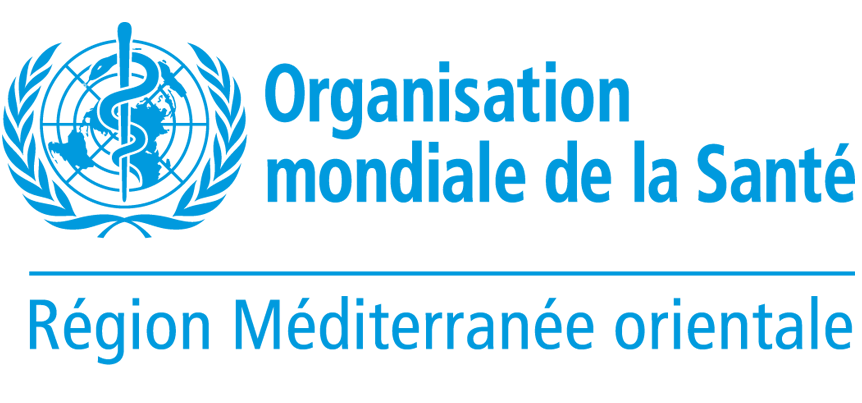Gaza: frontline health care innovation saves lives and reduces hospital load
 Patients are referred to the closest trauma stabilization point from the points of injury in northern Gaza. Photo: WHO18 May 2018 – During demonstrations in Gaza on 14 and 15 May, 62 Palestinians were killed, including one health worker, and 2768 injured, including 8 children. However, the toll could have been even higher without a recent emergency health care innovation.
Patients are referred to the closest trauma stabilization point from the points of injury in northern Gaza. Photo: WHO18 May 2018 – During demonstrations in Gaza on 14 and 15 May, 62 Palestinians were killed, including one health worker, and 2768 injured, including 8 children. However, the toll could have been even higher without a recent emergency health care innovation.
Called ‘trauma stabilization points’, or ‘TSPs’, these large tent-like structures are located within minutes of the frontline and serve as the first point of care in the trauma-care pathway (from injury to pre-clinical trauma management, surgery and ultimate recovery). In a TSP, life- or limb-threatening cases are reanimated, stabilized, and then referred to hospitals for definitive further treatment. With these first crucial steps, TSP health workers can save additional lives in Gaza while taking some pressure off hospitals, which are being overwhelmed with injured patients.
One such patient who came through a TSP is Waleed. Waleed was shot in his left leg during last Friday’s demonstrations and immediately brought to the nearest TSP only 3 minutes away. There, doctors determined the severity of his injuries, stabilized his wounds, administered IV fluids and analgesics, and prepared him for hospital transfer. After surgery, he will have to rest for several weeks and use crutches but with the intervention at the TSP, Waleed managed to avoid permanent damage to his leg, and possibly an amputation.
Waleed is relieved: "I cannot afford to be on crutches [for long], while my home is destroyed. I must continue the chores at home and ensure my sister Amina’s reading classes. Who else will do it? My father was blinded in 2014 as a result of an explosion during the 2014 war and my mother died of cancer when I was 4 years old.”
In Gaza, the World Health Organization (WHO) has supported the Ministry of Health to upgrade the 5 TSPs close to the site of the largely peaceful demonstrations and enhance coordination with the additional 5 established by the Palestinian Red Crescent Society (PRCS). In addition, WHO provided medical supplies to Gaza including drugs, disposables and assistive devices for patients like Waleed. WHO also coordinates the Gaza Trauma Working Group, a coordination group which improves clinical standards, patient referral, and documentation of trauma patients. On 15 May, WHO also activated its global emergency medical teams (EMTs) network in order to more effectively respond to the humanitarian crisis.
Waleed is far from the only injured person. Since the start of the demonstrations on 30 March, over 12 000 people have been injured, including 3500 who have gunshot wounds. The influx of people with injuries has overwhelmed the healthcare system in Gaza, which was already in crisis before the demonstrations began; WHO reported in May that 40% of nearly 500 essential medicines were completely depleted in Gaza.
"Our surgeons are exhausted”, says Dr Medhat Abbas, director of the Dar Al Shifa hospital. “Our capacity has reached its limit. We cannot cope, even with surgeons and specialists, practitioners and volunteers.” Still, Dr. Abbas acknowledges that without the work of surgeons and nurses in the TSPs, hospital capacity and the quality of emergency care may have collapsed: “TSPs have greatly reduced the burden on hospitals; there is no question about it.”
In addition to TSPs and hospitals, specialist rehabilitation is a third key part of the trauma-care pathway. Dr Ahmad Shaheen, coordinator of the Al Awda hospital: “Many areas of Gaza have focused on the acute care elements of the trauma pathway. Yet, rehabilitation is critical.” With proper rehabilitation and help from specialists, Waleed and all other injured people in Gaza have a new hope for a full recovery and a healthy future.
Following the death of a health worker, WHO reiterates its calls for the protection of all health staff and facilities
 One of the 211 health workers injured in demonstrations since 30 March being treated at a trauma stabilisation point in Gaza14 May 2018 – WHO is shocked and saddened to learn of the death of a health worker during demonstrations in Gaza, in addition to the dozens of civilians killed and wounded. WHO reiterates its calls for the protection of all health workers and health facilities.
One of the 211 health workers injured in demonstrations since 30 March being treated at a trauma stabilisation point in Gaza14 May 2018 – WHO is shocked and saddened to learn of the death of a health worker during demonstrations in Gaza, in addition to the dozens of civilians killed and wounded. WHO reiterates its calls for the protection of all health workers and health facilities.
Since the start of the demonstrations in Gaza on 30 March, WHO has documented an increasing number of attacks on health facilities and health personnel. As of 13 May, 211 health workers in Gaza were affected by health attacks while attending the large numbers of injured during mass demonstrations at the border fence. 9 sustained bullet wounds, 13 were injured by tear gas canisters and 189 suffered tear gas inhalation. 25 ambulances were also damaged.
Attacks on health facilities have severe consequences for health. They not only impact the health of staff and patients affected, but affect the capacity of a health system already debilitated by more than 10 years of blockade. In the immediate aftermath of a health attack, patients are deprived of potentially life-saving care at the frontline. In the longer term, the cumulative effect of attacks can lead to reduced availability of health care for the population, as well as affecting the longer-term health, including the mental health, of staff.
In May 2016, the UN Security Council adopted Resolution 2286, strongly condemning attacks against medical facilities and medical personnel. Medical facilities and personnel are protected under international law. The right to health incorporates protection from disproportionate uses of violence and the right to treatment in conflict situations extends without distinction to combatants and non-combatants.
Dr Gerald Rockenschaub, Head of the WHO office in the occupied Palestinian territory, stated: “Health workers and health facilities should be protected at all times. There are clear obligations to safeguard health care under international law and these have to be respected.”
Related link
Austrian Cooperation through the Austrian Development Agency and WHO sign cooperation agreement to boost emergency services in Gaza
 Jerusalem, 14 May, 2018 – With a priority focus on improving the primary and emergency health services in Gaza, the Austrian Cooperation, through the Austrian Development Agency (ADA) and WHO today signed a cooperation agreement for EUR 300,000, intended to help meet the health care needs in Gaza.
Jerusalem, 14 May, 2018 – With a priority focus on improving the primary and emergency health services in Gaza, the Austrian Cooperation, through the Austrian Development Agency (ADA) and WHO today signed a cooperation agreement for EUR 300,000, intended to help meet the health care needs in Gaza.
During the signing ceremony at the WHO premises in Jerusalem, Dr. Andrea Nasi, Austrian Representative in Ramallah, highlighted the work of the local WHO office in Palestine in their continuous effort to alleviate the plight of the Palestinian people and prevent the worst.
“We consider your work vital and thank you for it. Therefore, our contribution is intended to help you save lives, thus mitigating suffering and bitterness. As such, it is a most concrete and tangible expression of Austria’s consistent commitment to a negotiated two-state solution.”
This contribution comes very timely, as we hear the news about too many killed and severely injured in Gaza today. These funds will indeed help save lives,” said Dr. Gerald Rockenschaub, head of the WHO office in oPt.
For more information, please contact:
Health Cluster Workshop on Emergency Health Information Tools, May 2018
 10 May 2018 - oPt, Humanitarian actors and members of oPt Health Cluster attended a workshop led by the Health Cluster, in the West Bank and Gaza. Over 40 partners were trained on information tools developed by WHO as the lead cluster agency, in order to drive the emergency operational response on the ground.
10 May 2018 - oPt, Humanitarian actors and members of oPt Health Cluster attended a workshop led by the Health Cluster, in the West Bank and Gaza. Over 40 partners were trained on information tools developed by WHO as the lead cluster agency, in order to drive the emergency operational response on the ground.
Focusing on the current emergency situation in Gaza and the ongoing challenges facing the mobile health clinics in the West Bank, the workshop facilitated dialogue around information management as a fundamental tool to increase coordination and enhance the response.
Tools and resources available online include the Health Resources Availability Monitoring System (HeRAMS), Emergency Medical Teams (EMT) calendar, infographics, Situational Reports and the Health Cluster website, www.healthclusteropt.org.
“In the coming weeks, the Cluster will continue to develop online platforms for real time coordination and decision making”, Sara Halimah, Health Cluster Coordinator.








